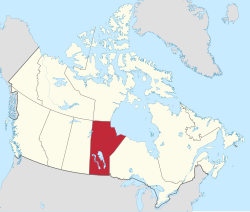

Manitoba is the fifth most populous province in Canada with 1,342,153 residents as of 2021 and is the sixth largest in land area at 540,310 km2 (208,610 sq mi).[1] Manitoba's 137 municipalities[2] cover only 21% of the province's land mass yet are home to 95% of its population.[3][a] These municipalities provide local government services to their residents.
A municipality in Manitoba is "a municipality that is continued or formed under" the Municipal Act, which was enacted in 1996.[4] Municipalities that can be formed under this legislation include urban municipalities (cities, towns and villages) and rural municipalities.[4] The Local Government Districts Act, enacted in 1987, allows the formation of local government districts as another municipality type.[5] Of Manitoba's 137 municipalities, 37 of them are urban municipalities (10 cities, 25 towns and 2 villages), 98 are rural municipalities and 2 are local government districts.[6][7] The Municipal Act and the Local Government Districts Act stipulate governance of these municipalities.[4][5] Additional charters or acts are in place specifically for the cities of Brandon, Flin Flon, Portage la Prairie, Thompson and Winnipeg, the towns of Morris and Winnipeg Beach, and the rural municipalities of Kelsey, St. Andrews and Victoria Beach.[8] The Municipal Act, the Local Government Districts Act, and all these additional acts and charters were enacted at the provincial level by the Lieutenant Governor of Manitoba on the advice and consent of the Legislative Assembly of Manitoba.[4][5][8] The Government of Manitoba's Department of Municipal Relations responsible for providing provincial services to municipalities.[9]
Over half of Manitoba's population resides in the City of Winnipeg, the provincial capital, with a population with 749,607.[3] The City of Brandon is the province's second most populous municipality with 51,313 residents.[3] Manitoba's smallest municipality by population is the Local Government District of Mystery Lake with 0 residents.[3] The largest municipality by land area is the Rural Municipality (RM) of Reynolds at 3,559.65 km2 (1,374.39 sq mi), while the smallest by land area is the Village of Arborg at 2.22 km2 (0.86 sq mi).[3]
Manitoba's first municipality was the RM of Springfield (originally Springfield-Sunnyside).[10] It was incorporated on September 27, 1873.[11] Winnipeg was incorporated as a city a few weeks later on November 8, 1873.[12]
- ^ "Population and dwelling counts, for Canada, provinces and territories, 2021 and 2016 censuses – 100% data". Statistics Canada. March 14, 2022. Retrieved March 14, 2022.
- ^ "Report of Manitoba Local Government" (PDF). Manitoba Department of Local Government. Archived from the original (PDF) on February 14, 2015. Retrieved September 12, 2013.
- ^ a b c d e f Cite error: The named reference
2021censuswas invoked but never defined (see the help page). - ^ a b c d "The Municipal Act (enacted 1996)". Government of Manitoba. September 12, 2013. Retrieved September 16, 2013.
- ^ a b c Cite error: The named reference
LGDActwas invoked but never defined (see the help page). - ^ Cite error: The named reference
StatCaninterimwas invoked but never defined (see the help page). - ^ "2010 Statistical Information for Municipalities in the Province of Manitoba" (PDF). Manitoba Department of Local Government. Archived from the original (PDF) on September 29, 2013. Retrieved September 12, 2013.
- ^ a b "Municipal Acts". Government of Manitoba. September 12, 2013. Retrieved September 16, 2013.
- ^ "Manitoba Local Government". Province of Manitoba. Retrieved September 27, 2013.
- ^ "Regional Profiles – Tourism Profiles – RM of Springfield". Partnership of the Manitoba Capital Region. Archived from the original on September 9, 2013. Retrieved September 10, 2013.
- ^ "Manitoba Municipalities: Springfield". The Manitoba Historical Society. August 2, 2013. Retrieved September 10, 2013.
- ^ "The Incorporation of Winnipeg". The Manitoba Historical Society. June 30, 2009. Retrieved September 10, 2013.
Cite error: There are <ref group=lower-alpha> tags or {{efn}} templates on this page, but the references will not show without a {{reflist|group=lower-alpha}} template or {{notelist}} template (see the help page).